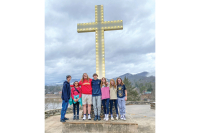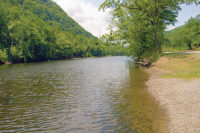Downward row: NOC guide canoes to world record waterfall run
 It wasn’t until Brad McMillan got his canoe on the water that the moment hit him. He’d been preparing for this for a long time, both mentally and physically, and he’d just watched his three friends in kayaks descend the falls before him. But once in the water, he struggled to keep the calm of that preparation. Nothing makes the idea of running a 70-foot-high waterfall more concrete than, well, pushing off to run a 70-foot-high waterfall.
It wasn’t until Brad McMillan got his canoe on the water that the moment hit him. He’d been preparing for this for a long time, both mentally and physically, and he’d just watched his three friends in kayaks descend the falls before him. But once in the water, he struggled to keep the calm of that preparation. Nothing makes the idea of running a 70-foot-high waterfall more concrete than, well, pushing off to run a 70-foot-high waterfall.
“It was terrifying,” said McMillan, 27. “I was completely calm in the time leading up to me getting there and getting geared up and getting prepared to go run it, and then watching the other three guys go first I was still pretty calm. Every once in a while I’d get a little spike in my heart rate just thinking about it. Once I got my boat down to the water I started freaking out that I was really about to do that.”
If successful, McMillan’s run on Alabama’s DeSoto Falls would set a world record for the height of a waterfall run in an open canoe. If something went wrong, though, it could go really wrong. Broken bones, concussions or worse could all be waiting at the bottom. But as he prepared to steer toward the edge McMillan pushed those images out of his mind, concentrating on one thing only: moving the boat along the correct line.
“I just told myself that I’ve gotta clear all that from my head and just think about what I need to do to make this work,” McMillan said.
A deep breath, a few strokes and a heart-jolting free-fall later, and McMillan was 10 feet below the water and surging back toward the surface. It had worked.
“It was pretty cool just looking back up after I ran that waterfall,” McMillan said, “looking back up at it and seeing how big it was and seeing how far I just fell. It was pretty wild.”
Related Items
The venture earned McMillan a place in the record books, edging out the previous title set by Jim Coffey for running 60-foot La Cascada de Truchas on the Alseseca River in Mexico. Coffey had held the record for just six months, but his run bested the record set 20 years previously by Steve Frasier, who ran a 55-foot waterfall on the Elk River in North Carolina.
Nabbing the world record felt pretty good, McMillan said, but it was nothing compared to the satisfaction of walking away from DeSoto unscathed, knowing that he had what it took to conquer it. With all that distance of air between him and the churning water below, his only injury was a tiny bump on the chin.
But it was the process of acquiring those skills that was the real story, a tale with far more plot than the 10 seconds or so it took to descend from the top of the falls to the churning water below.
When McMillan became a world record holder on April 8, 2014, he already had a 20-year paddling career behind him. He started rafting at age 7 and got his first kayak at age 12. When he turned 19, the Valdosta, Ga., native began working summers as a guide with Nantahala Outdoor Center, moving north four years later to work there fulltime. Over the past three years, he’s transitioned to raft repair, about the same time that he began to take up canoeing. When he’s not at NOC, he’s in Idaho, or Washington, or Austria, or any other of a number of places, competing in paddling races. Suffice it to say, McMillan has a spent a good chunk of his life on the water.
“I live and work on the Nantahala River, so I’ve got a great training ground right there. At work I can take an hour off for work and go paddle every day of the week,” McMillan said.
He’s on the water six to seven days a week, and with a flexible work schedule, he can build his hours around the water’s behavior, taking off when paddling is prime.
“I feel that that has been a huge part of me being able to progress as a paddler,” he said.
Of course, running a few practice falls helps, too. Last summer, McMillan and his canoe took a trip out west, conquering a 25-foot waterfall while paddling the Green Truss of the White Salmon River, then a 30-footer on the Little White Salmon River in Washington and finally a 45-footer on the White River in Oregon. The excursion started out as a just-for-fun venture, but eventually it gained a larger purpose.
The goal: to work up to a world record.
“I have a friend of mine that went and ran [DeSoto] last spring, so 2013,” McMillan said. “He’d run a number of other really pretty big waterfalls and he said that one was the softest 70-footer probably in the world.”
The “softer” a waterfall is, the more the water folds in on itself and the more aerated it is. That means that the water doesn’t stop a falling boat quite as quickly as it otherwise would, giving the paddler’s body more time to catch up with the boat’s halt.
Otherwise, McMillan said, “It’s going to be a harder impact. The boat will just stop and you kind of continue going, and that’s when bones break and bad stuff happens.”
That can be an even harder outcome to prevent in a canoe, because canoes generally have a lot more volume and surface area than do kayaks. A typical kayak is about 90 gallons in volume, while canoes are usually in the 120- to 150-gallon range.
“You’ve got a lot more boat that you’re trying to plug in through the water as opposed to just stopping when you hit the pool,” McMillan explained.
To give himself the best shot at plugging through, McMillan used his Blackfly Option canoe, a rotomolded polyethylene boat with a pointed bow well-suited for plowing through water.
With the boat, the practice and the drive, all McMillan had to do was wait for the rain. More rain means more water, which means an easier landing at the bottom of the falls.
The day before the record-breaking run, several inches of water dumped on the West Fork of the Little River, which feeds DeSoto Falls. McMillan saw the rain coming and immediately adjusted his schedule, stuffing in some work hours before heading to Chattanooga for an overnight and from there to Mentone, Ala. By the time the group arrived at DeSoto, the rain was finished and the river was running high. Conditions looked great, and the three kayakers took the plunge before turning the show over to McMillan.
Soon, he was sitting at the base, staring up at the roaring falls above, knowing that he’d done something to be proud of.
“I’ve been paddling for nearly 20 years, and I feel like everything that I’ve done before that point was training to be able to successfully complete that drop,” he said. “It’s not really thinking about the bad and the risk, I guess, of the drop. You definitely think about that before you do it, but I knew that I was capable of running that waterfall successfully and not getting hurt.”
As for a next step, though, that’s still an open question. McMillan’s got the next hurdle pinpointed, but he’s still working through the risk-reward analysis of it. The top of the falls is no time to think about what could go wrong, but the planning stage is.
“I would love to step it up and run an even bigger waterfall,” he said, “but it’s just kind of asking yourself at what point is it too tall.”
But regardless of what form the next challenge will take, McMillan said, he definitely has his sights set on something. For now, he’s got a full slate of kayaking races out West — he was in Idaho when The Smoky Mountain News caught up with him — to keep him busy, but he’s got that adrenaline junkie thing going, demanding that the next big run come soon.
And really, McMillan said, that feeling of terror laced with accomplishment is the goal, bigger than any record book entry that might result along the way.
“A world record’s cool, but if somebody beat it today I wouldn’t have my feelings hurt,” he said. “It was just cool to run that huge waterfall and be scared for a little bit.”









